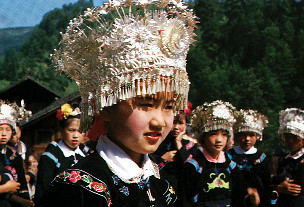Living Buddha: Tibetan culture well preserved
The Tibetan delegation of the National People's Congress, China's top legislature, holds a press conference in Washington, the United States, on March 17, 2009 The unique culture of the Tibetan people is well preserved in China and the claims that the Tibetan culture is nearing extinction are simply not true, a living Buddha of Tibetan Buddhism said here
Chinese Traditional Art---- Papercut
Papercuts refer to handicrafts made by cuttingpaperwith scissors to form different patterns and pasting them on walls, windows, doors and ceilings. With their long history, papercuts, which originated in China, have been very popular among the ordinary people of China. The first papercut can be traced back to theNorthern and Southern Dynasties(386-581) period. The initiation and
Funny...ha-ha or peculiar?
Every culture has its own sense of humor. That's why Jim Carrey in The Mask might not make all Chinese people laugh, but a piece of crosstalk can. The Chinese do humor in several forms: xiangsheng (crosstalk) was the most popular, then came xiaopin (comic skit), and now errenzhuan (two-person sketch). Crosstalk, known in China as the "art of laughter", is a traditional art
Let your fingers do
In Peking Opera, finger movements express different emotions and characters. For actresses, this is called "orchid fingers", because it looks like flowers. Mei Lanfang, one of the most famous Peking Opera artists, developed and created many beautiful finger patterns as well as colorful make-up. International opera fans used to say that his hands had a kind of "intoxicating
Crouching tigers in small viliage
In Chinese culture, tiger is an auspicious and sacred animal, avatar of one of the heavenly guardians. Its image is believed to have magical powers, capable of warding off evil from a home and blessing the family lasting peace. That is why so many Chinese households are used to hanging tiger pictures on the front walls of sitting rooms. A boy plays ball in front of a wall painted
China Jade History
The Chinese regard carved jade objects as intrinsically valuable, and they metaphorically equate jade with human virtue due to its solidity, durability and (moral) beauty. Many countries boast a jadeware culture, but none of them can match China's long jadeware history. In China, jadeware underwent a long process of development beginning from the New Stone Age 10,000 years ago. The
Batic: Pearl of Art
Batik, one of the oldest handicrafts, has been appreciated as a part of ancient Chinese civilization since the foundation of dyeing and weaving technology in China. It is a traditional Chinese folk art which combines both painting and dyeing. Batik, also known as laran or wax printing, is an artistic technique used by dipping a specially designed knife into melted wax and painting
Chinese Traditional Art---- Xihe Dagu (Big Drum)
Famous Star of Xihe Dagu---Yangyaqin Xihe daguforms the biggest family in the art of dagu, literally meaning "big drum." It has a very long history with a huge audience in Hebei andShandong provinces,TianjinandBeijingmunicipalities, and Northeast and Northwest China. Xihe dagu originated from the Xianzishu and Muban dagu in the central area ofHubei Provinceduring the
Tangka Art----Treasure of Tibet
Clusters of white clouds drifting across the blue sky, paths winding through snowy mountains, and Buddhist temples looming in infused incense--these are the images most people have of Tibet, the land of eternal mystery. And when it comes to the art treasures of the region, no image is more intrinsically associated with Tibet than the iconic Tangkas. "Thangka," also known as
The Romance of butterfly lovers
Butterfly Lovers According to legend, Zhu Yingtai assumes a male identity so she may travel to study in Hangzhou, a southern city in China, where she meets Liang Shanbo. In the course of their studies, Zhu and Liang become very close friends. From a Confucian perspective, the notion of "Junzi" (gentleman) is a
Total: 159 Items This is 1 Page( 10 Items/Page) Result Page: 16 Pages First Previous Next LastArt
 more
moreU.S. space shuttle Discovery lifts
The space shuttle Discovery takes off from launch pad

Obama administration vows to break

Irving dual-language students
Melissa Reyna (center) and Johanna Sanchez

Dev, Denny to quizz for charity
Director Danny Boyle (R) holds his Oscar for

Custom
 more
moreProvinces Site
Chinese Medicine
 more
more









